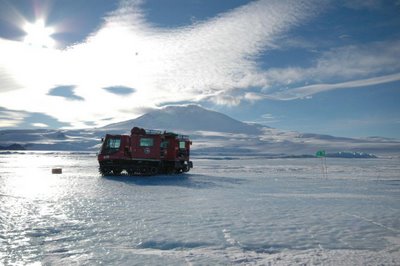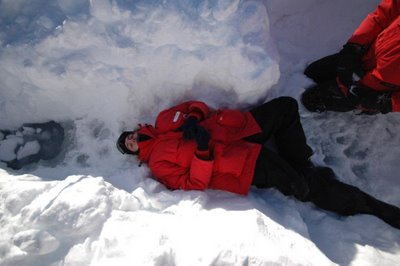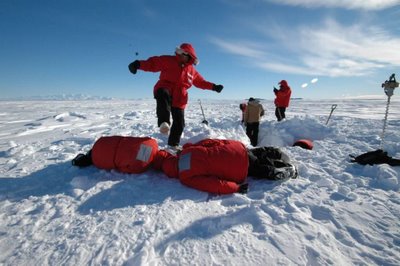
The site we picked has plenty of beautiful ice formations, as pressure ridges abound, causing the sea ice to fracture and rise up. While it is beautiful, it is also quite dangerous, but I'll get to that in a bit. We chose this location as it is where Weddell seals have historically congregated. As they are mammals, they need oxygen, yet they feed in the water, so they must find locations where they have access to both. Pressure ridges provide excellent opportunities as the ice has frequent openings which allow the seals to hull out, and get back to the water. These seals then keep the holes open by chewing the ice with their large teeth.
Getting out of the piston bully the landscape was stunning, and the clear sky allowed us to see all the mountains in the distance, as well as Mt. Erebus, which will dominate my landscape for the next several months. The second thing I noticed was the cold. It was approximately -50 with wind chill, and even with all the gear we wear you could feel it in your bones. Several people got very minor frostbite, and all of us had frozen eye lashes and facial hair. Within seconds of removing my mittens to take pictures I lost all sensation in my fingers, just a normal day here.
The sea ice can be treacherous, and to the untrained eye, quite dangerous. As the ice cracks, water can come to the surface, but due to the extreme temperatures it quickly freezes over, though often only a very thin layer. The gusts of wind caused the snow to drift into the cracks, filling these crevasses to the eye, but if you step into them, or drive over them, you risk a fall. We learned how to identify these hidden dangers, and how to detect just how dangerous they are. We did quite a bit of shoveling and drilling to determine the thickness, and also marked those areas we found which were quite dangerous.
Getting out of the piston bully the landscape was stunning, and the clear sky allowed us to see all the mountains in the distance, as well as Mt. Erebus, which will dominate my landscape for the next several months. The second thing I noticed was the cold. It was approximately -50 with wind chill, and even with all the gear we wear you could feel it in your bones. Several people got very minor frostbite, and all of us had frozen eye lashes and facial hair. Within seconds of removing my mittens to take pictures I lost all sensation in my fingers, just a normal day here.
The sea ice can be treacherous, and to the untrained eye, quite dangerous. As the ice cracks, water can come to the surface, but due to the extreme temperatures it quickly freezes over, though often only a very thin layer. The gusts of wind caused the snow to drift into the cracks, filling these crevasses to the eye, but if you step into them, or drive over them, you risk a fall. We learned how to identify these hidden dangers, and how to detect just how dangerous they are. We did quite a bit of shoveling and drilling to determine the thickness, and also marked those areas we found which were quite dangerous.

In some places the ice was over 10 feet thick, a very safe and healthy depth. It is on this thickness where we will set up camp. In the pressure ridges however, we found open holes, or more accurately I found an open hole. We found the ridge, and were in the process of shoveling it out for depth drilling when my foot fell in!
 It was a bit of a shock to see the open ocean below, and luckily I did not go in past my ankle, but it was a great reminder of where we are. After we finished shoveling out that area of the crack, we realized this pressure ridge ran a very long distance, possibly all the way to the Erebus glacier tongue. While it is still very early in the season and the ice is somewhat stable, later in the summer the decay of the ice will speed up rapidly, and caution will become more and more important. Caution as many of you know is not always my strong suit, but I think these conditions warrant me to really slow down, but enough of the scary part.
It was a bit of a shock to see the open ocean below, and luckily I did not go in past my ankle, but it was a great reminder of where we are. After we finished shoveling out that area of the crack, we realized this pressure ridge ran a very long distance, possibly all the way to the Erebus glacier tongue. While it is still very early in the season and the ice is somewhat stable, later in the summer the decay of the ice will speed up rapidly, and caution will become more and more important. Caution as many of you know is not always my strong suit, but I think these conditions warrant me to really slow down, but enough of the scary part. The great excitement of the day came when we heard our seals below the ice. Weddell's are very vocal, and we heard one, a male presumably, calling from the icy waters below. The call is quite an eerie noise, but it proved we were in face in seal country. We presume the seal was excited by the light coming through the newly excavated hole, and may have been calling to others. We now know our camp is in the right place, and hopefully seals will begin to pull out in short order and give birth to their pups.

1 comment:
Hi Dan! I stopped by to say hello via Charley of Courage.
What a cool blog you have. I'll be back.
Post a Comment